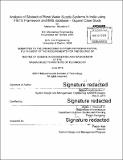Analysis of slipback of rural water supply systems in India using FIETS framework and IMIS database : Gujarat Case Study
Author(s)
Novellino Fajardo, Marianna Isabel, 1978-
DownloadFull printable version (35.97Mb)
Other Contributors
System Design and Management Program.
Advisor
James L. Wescoat Jr.
Terms of use
Metadata
Show full item recordAbstract
The objective of this project is to address the failure rate or "slipback" of rural water supply systems in India by analyzing performance of previous water projects using the national government database called IMIS. Data analysis and visualization tools are used on the IMIS in combination with the FIETS framework for sustainability enabling the categorization of variables into Financial, Institutional, Environmental, Technological, and Social factors. This analysis provides an evaluation of the IMIS database and how it can be used to meet the FIETS categories. It also provides quantitative metrics of slipback of water supply systems based on the available variables, helping identify correlations to problem areas and FIETS variables, enabling data-driven actions to promote sustainability. This assessment is designed based on the state of Gujarat - a generally successful model of water management projects in India - for the developing stage. The Jamnagar district was selected for the sub-district level analysis. Results show that IMIS database has data that satisfy FIETS factors at state and district levels. There are some limitations on data visibility between these two geographical levels but in both cases a complete analysis of FIETS factors is possible. A gap data analysis provides a detailed list of what are the available variables and which ones are missing from the database. In the case of Gujarat there is a high coverage of water supply in the rural areas, which makes challenging to find correlations with FIETS factors. Significant positive correlation was identified between low covered areas and districts with high Scheduled Tribal population. There was no correlation between expenditures and low coverage areas or built infrastructure. At sub-district level there are less variables available for analysis and correlations were found to be similar to the state findings. Field visits were made to several villages in Jamnagar that raised questions about the water quality data as well as coverage. The use of IMIS database to improve the rural water supply sector is very recent and further research is recommended to improve the data collection process, enabling decision-makers to understand better IMIS data, and pilot test this analysis to improve the annual planning of water supply systems at district and state levels.
Description
Thesis: S.M. in Engineering and Management, Massachusetts Institute of Technology, Engineering Systems Division, System Design and Management Program, 2015. Cataloged from PDF version of thesis. Includes bibliographical references (pages 141-143).
Date issued
2015Department
System Design and Management Program.; Massachusetts Institute of Technology. Engineering Systems DivisionPublisher
Massachusetts Institute of Technology
Keywords
Engineering Systems Division., System Design and Management Program.